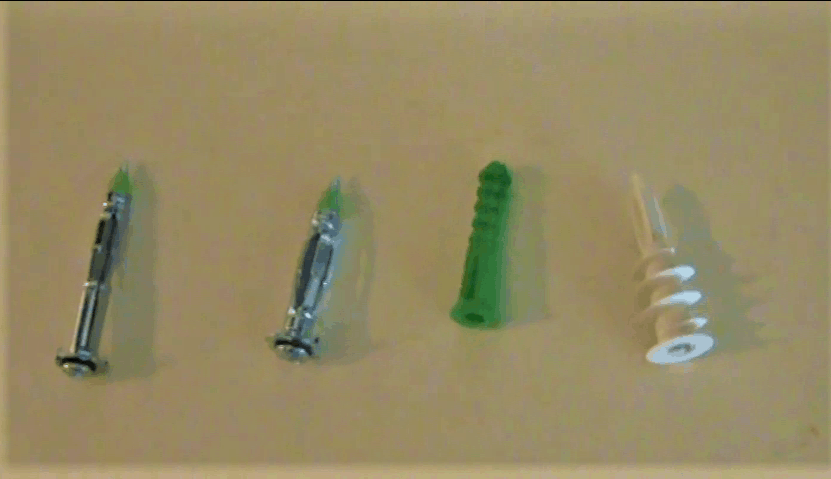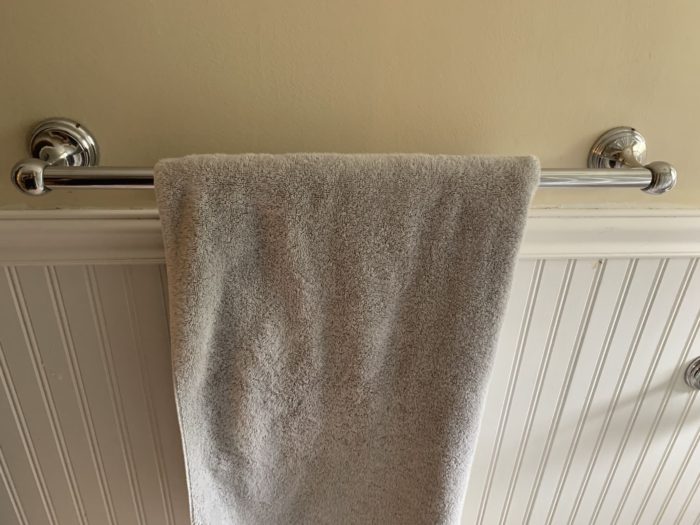This post may contain affiliate links. Please read the disclosure for more info.
As an avid DIY’er and homeowner that tries to avoid calling in any professional for projects that I believe I can tackle like putting up a towel rod in the bathroom I have come across those pesky towel bars that come loose from the wall due to the wrong anchors being used, a kid hanging on it like a jungle gym or the hole is just stripped out over time and due to overuse. Through this experience I have learned what is the best method for repairing the towel bar if it came loose, ensuring the towel bar stays put after a repair and ensuring it is kid proof!
How to repair a loose towel bar? To repair a loose towel bar, you must first remove the existing towel bar by loosening the set screws from underneath and remove it from the wall. Once the set screws are loose on both sides you can pull it from the brackets that are attached to the wall. Once the bar is removed you can loosen the screws holding the brackets on the wall to reinforce the anchors holding the towel bar on the wall. You will want to insert your new anchors, if you need to enlarge the holes with a screwdriver or drill bit, then tighten down the new anchor’s screws and brackets. Once the brackets are reinstalled with the new anchors reinstall the towel bar by inserting it over the brackets and tightening the set screws.
In order to ensure that the towel bar and anchors are properly secured to the wall and will withstand the daily wear and tear you want to ensure that you are using the right anchors for the right material.
Continue reading below to learn more or watch the video which includes tips and tricks to make the entire process that much easier!
Jump To:
Process for installing or repairing a towel bar

Let’s keep this simple so if you already have holes from a previous towel bar you can skip ahead, but if it’s a new install you must first determine the height and width to mark out where the brackets will be installed. The general height for a towel bar is 48 inches from the floor and come in various widths so please refer to the template that is provided with the towel bar to determine the proper width. Holding the template at 48 inches from the floor and using the level to ensure it is level mark the holes for the brackets on the level using the pencil. Drill the pilot holes for the anchors where the pencil marks are. Install the anchors, using the screws provide drive the screws through the mounting brackets into the wall anchors until it pulls tight. Attach the towel bracket over the mounting bracket installed on the wall and tighten the set screw. Attach the second mounting bracket by driving the screws provided through the wall anchor until it pulls tight. With the rod inserted into the second towel bracket, place the towel bracket over the mounting screw and tighten the set screw. Once both set screws are tight just hang your towel, step back and admire your handy work.
If you are installing a new towel bar just follow the same steps for your anchor installation however you will need to determine the width and height you want the towel bar installed at. General guidelines install the bathroom towel bar at 48 inches from the floor. If you are installing the towel bar in a children’s bath you would want to install the towel bar at 36 inches from the floor.
What are the different types of drywall anchors?
There are generally five types of drywall anchors:
- Hollow wall anchors or Molly bolts:
- Used for medium duty applications in the 50 pounds range depending on the thickness of the drywall
- These types of anchors add an anchor that will provide permanent threads to the application area and expand as the screw is driven into the anchor.
- These are my go-to anchors for most applications with drywall
- Plastic Hollow Wall Plug:
- Used for light duty applications in the 15 – 20 pounds range depending on the thickness of the drywall
- These types of anchors expand and lock into place when the screw is driven into the anchor.
- Threaded Drywall Anchors or Zip-its:
- Used for light duty applications in the 15 – 25 pounds range depending on the thickness of the drywall
- These types of anchors resemble large screws that have large threads that grip tightly to the drywall and provide a strong hold and are resistant to stripping the hole and being pulled out
- Toggle bolts:
- Used for medium to heavy applications in the range of 150 – 300 pounds range depending on the thickness of the drywall
- These types of anchors have two parts: the toggle and the bolt. As the bolt is driven into the hole the toggle is pulled securely to the inside of the drywall for a
strong hold . The drawback is it does require a pilot hole and the larger the toggle the better the strength but the larger the bolt which can be an issue for some applications and wall thickness.
- Winged plastic anchors:
- Used for light to medium in the 25 – 35 pounds range depending on the thickness of the drywall
- These types of anchors require a special tool to expand the wings of the anchor inside the wall but offer better strength than the plastic
hollow wall plugs.
What tools will you need to install a towel bar in drywall?
Remember, you would like to install your towel bar or any fixture in the bathroom to a wall stud where it is possible. This can be accomplished by simply using wood screws instead of drywall anchors and screws. For this example, we will discuss how to install a towel bar into drywall using anchors but many of the other steps are still the same. In addition to the towel bar and brackets, you will need drywall anchors, allen keys, a drill, a drill bit that matches the size of the anchor used, a level, a measuring tape, and pencil.
What tools will you need to install a towel bar in tile?
To install a towel bar into tile the tools required and the process is very similar to installing a towel bar into drywall with the exception of the type of anchors used and the type of drill bit used. For tile, you will use a masonry bit and use plastic tube anchors. As with
Now that we know more about how to install a towel bar in drywall and tile as well as the anchors and tools required let’s learn more about how to choose the right anchors?
How to choose the right anchors?

In order to determine the right anchors to attach the towel bar to you should understand the material being used. For drywall, you will be fine with either choice, but I prefer the Molly bolts for ease of use with medium to heavy duty applications based on their strength and stability over time. Be sure you get the right size for the thickness of your drywall. I have had great success with this type of anchor and I believe they stand the test of time while simplifying the install. To install a Molly bolt simply drill a pilot hole the same thickness as the anchor, use a hammer to tap it into place, but remember most Molly bolts have teeth on them that dig into the drywall so be sure to hammer them into place until they are flush with the drywall surface. Once the Molly bolt is installed you can simply attach the brackets using the bolt and tighten fully. This bolt, installed properly, should last until your next bathroom remodel. Remember if you are installing a towel bar near the shower or where it will impact water you should choose an anchor that will not rust over time, like plastic or those coated for protection.

